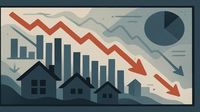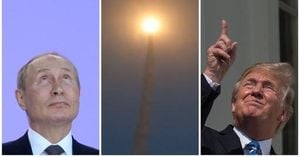Americans are staring down the barrel of economic uncertainty as warnings of a looming recession gather steam, even as official statistics paint a rosier picture. Recent polling and expert analysis suggest that beneath the surface, anxiety about jobs, housing, and the future is running high—and policymakers on all sides are scrambling to respond.
On September 2, 2025, The Wall Street Journal released a poll that sent shockwaves through political and economic circles. Only 25% of Americans said they believe they have a good chance of improving their standard of living, while almost 70% stated that hard work is no longer enough to get ahead. Perhaps even more sobering, more than three-quarters of respondents expressed little confidence that future generations will be better off than they are today.
It’s a striking disconnect: official unemployment and inflation rates remain low by historical standards, yet the mood on Main Street is anything but optimistic. According to The Wall Street Journal, fewer than a quarter of Americans feel confident they could buy a home if they wanted, and 56% admit to having little or no confidence in their ability to do so. Housing affordability, it seems, is at the heart of the nation’s malaise.
Democratic pollster John Anzalone took to social media to stress the urgency of the moment, saying the poll “shows how important it is for Dems to get a strong economic message,” given that “70% of people said they believe the American dream no longer holds true.” Democratic strategist Dan Ancona homed in on a finding that a majority believe former President Donald Trump and the GOP “are trying to scare and divide Americans so they can cut their own taxes and keep wealth flowing to the very rich.” Even among Trump’s own 2024 voters, about 27% agreed with that sentiment, suggesting economic populism is resonating across party lines.
Representative Ro Khanna (D-Calif.) weighed in as well, arguing, “We must tackle the economic divides tearing our nation apart and make the economic independence of every family and community our highest mission. I call it a new economic patriotism.” Former Labor Secretary Robert Reich, meanwhile, pointed to the chasm between CEO and worker pay, noting, “CEO pay is up 1,085% since 1978, while worker pay is up just 24%. Millions live paycheck to paycheck as they struggle to afford basic goods. Is it any wonder why 70% of people said they believe the American dream no longer holds true or never did?”
But it’s not just politicians and pollsters sounding the alarm. Mark Zandi, chief economist at Moody’s Analytics and one of the first to forecast the 2008 financial crisis, has been vocal in recent weeks about the risks facing the U.S. economy. In a series of interviews with Newsweek, Zandi outlined a cascade of concerns: “I don’t think the economy is in a recession, at least not at this point,” he said, “but it feels like it’s on the brink, it’s on the precipice of this recession.”
According to Zandi, the most urgent warning sign is jobs. “Job growth has slowed sharply this year and in the last few months has come to a virtual standstill. That job growth that we are getting is very narrowly concentrated in a few industries: health care, educational services, state and local government.” The only thing holding back a full-blown downturn, he suggested, is the fact that layoffs remain low. “That’s the firewall between recession and no recession, is the low layoffs,” Zandi explained. “As soon as you see negative employment—payroll employment decline in a month—that’s when alarm bells should start going off. And I would anticipate that that’s going to happen, and that’s going happen soon.”
Other economic indicators are also flashing red. GDP growth in the first half of 2025 was just over 1% annualized, and consumer spending has stagnated. Manufacturing and construction are contracting, with transportation and distribution already in recession. Zandi points out that states representing around a third of the U.S. economy—especially California and New York, which together account for over 20% of national GDP—are “treading water.” “What happens with California and New York may decide what happens to the nation,” he said. “If California and New York weaken and start to contract, the national economy is going to go into recession.”
Housing, in particular, is a sore spot. Zandi called the sector “very troubled,” noting that inventories of unsold homes are now as high as they were before the 2008 global financial crisis. The incentives that have kept single-family homebuilding afloat—such as interest rate buy-downs—are no longer working, and a construction slowdown could deepen the recession risk. “Home building is gonna weaken here very significantly. And that’s just another reason to be nervous about the economy’s staying power,” he told Newsweek.
What’s driving these headwinds? Zandi is blunt: “It’s the tariffs and it’s the restrictive immigration policy. Those two things are doing real damage to the economy.” He argues that these policies, championed by the Trump administration, have created uncertainty and directly contributed to rising prices and a labor force that’s no longer growing. “Prices are already rising, you can see it in the data, but it’s going to rise to a degree that it will be impossible for people to ignore. They’ll see it clearly in the things that they’re buying on an everyday basis.”
The administration, for its part, touts strong GDP growth, foreign investment, and controlled inflation as proof that its “America First” agenda is working. When asked about Zandi’s concerns, the White House told Newsweek that critics have made “these same doom-and-gloom predictions during President Trump’s first term—when his America First agenda ushered in historic job, wage, investment, and economic growth.”
Still, Zandi isn’t alone in his worries. Investment bank UBS has raised the probability of a recession in the near future, warning of a possible period of “stagflation”—that is, a stagnating economy paired with rising inflation, reminiscent of the 1970s. “The key message is the US economy, by these hard data measures, is locked in a prolonged phase of stagnation or slow contraction, warranting caution even as outright collapse has not yet materialized,” wrote Fortune.
Despite the gloom, Zandi does see some long-term strengths, particularly in the technology sector. The boom in artificial intelligence, he notes, is having “real and significant, very positive economic consequences.” But he cautions that unless policymakers address the underlying issues—tariffs, immigration, and housing—the nation’s economic resilience may not be enough to stave off a downturn.
For millions of Americans, the debate is no longer academic. The question is whether the “American dream” can be revived—or whether, as so many now fear, it’s slipping further out of reach.




